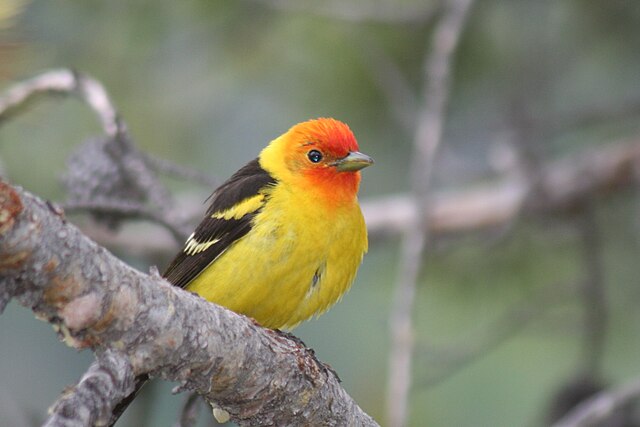The United States hosts a captivating array of beautiful birds, each contributing to the country’s rich avian diversity. From the iconic bald eagle symbolizing strength and freedom to the vibrant northern cardinal and the exotic peacock, these birds grace the American skies with their stunning plumage, adding color and elegance to the nation’s landscapes.
Bald Eagle (Haliaeetus leucocephalus)


A symbol of strength and freedom, the Bald Eagle is known for its white head and tail, contrasting with a dark brown body and large, hooked yellow beak. They are often seen near rivers and lakes where they hunt for fish.
Northern Cardinal (Cardinalis cardinalis)
The male Northern Cardinal is famous for its bright red plumage and a distinctive crest, while females are a subtle tan color with red highlights. These birds are commonly found in gardens and wooded areas, known for their clear, melodious songs.


Blue Jay (Cyanocitta cristata)
Recognized by its vibrant blue feathers, white chest, and black markings around the neck and head. Blue Jays are intelligent and adaptable birds, known for their loud calls and complex social behavior.
American Goldfinch (Spinus tristis)
Renowned for its bright yellow plumage in males during the breeding season, contrasted with black wings and white markings. They are often found in weedy fields and gardens, feeding on seeds.


Painted Bunting (Passerina ciris)
The male Painted Bunting is one of the most colorful birds in North America, with a mix of bright blue, green, and red plumage. These birds are shy and often found in dense brushy habitats.


Anna’s Hummingbird (Calypte anna)
Notable for its beautiful green and rose-pink plumage, Anna’s Hummingbird is a year-round resident of the Pacific Coast. They are known for their remarkable flying ability, including a dazzling courtship display.


Scarlet Tanager (Piranga olivacea)
The male Scarlet Tanager is a vivid red with black wings, creating a striking contrast in the green leaves of forest canopies where they reside. Females and non-breeding males are olive-yellow, much less conspicuous.


Indigo Bunting (Passerina cyanea)
These small birds are strikingly beautiful, with males showcasing a vibrant indigo blue in the breeding season. They are often found in open woodlands and edges of fields.


Mountain Bluebird (Sialia currucoides)
Exhibiting a stunning sky-blue color, more vibrant in males, the Mountain Bluebird is often found in open country and mountains of the West. They nest in holes in trees or nest boxes and feed on insects and berries.


Roseate Spoonbill (Platalea ajaja)
With its distinct pink plumage and spoon-shaped bill, the Roseate Spoonbill is a standout in coastal marshes and wetlands. They feed in shallow waters, swinging their bills side to side to catch small fish and crustaceans.


Wood Duck (Aix sponsa)
Known for its striking plumage, the male Wood Duck has iridescent green and purple feathers with bold white markings, while females are elegantly mottled brown. They are commonly found in wooded swamps and streams.


Green Jay (Cyanocorax yncas)
Native to South Texas, the Green Jay is known for its bright green, blue, and black plumage. These social birds are often seen in family groups, foraging for insects and fruits.


Western Tanager (Piranga ludoviciana)
Males have a bright yellow body, black back, and a red head, making them one of the most colorful birds in the western forests. They are often found in open woods and forests, feeding on insects and fruits.


American Kestrel (Falco sparverius)
The smallest falcon in North America, it is admired for its beautiful plumage, characterized by a mix of blue, orange, and brown. These birds are commonly seen perched on wires or hovering over fields, hunting for insects and small mammals.


Lazuli Bunting (Passerina amoena)
The male Lazuli Bunting is a stunning sight with its bright blue head and back, contrasting with an orange breast and white belly. They are typically found in shrubby habitats and open woodlands in the West.


Snowy Owl (Bubo scandiacus
These impressive owls are known for their predominantly white plumage, which helps them blend into their Arctic surroundings. They occasionally migrate south in the winter, thrilling birdwatchers across the northern United States.


Baltimore Oriole (Icterus galbula)
Known for its striking orange and black plumage, the Baltimore Oriole is often found in open woods, riverside groves, and backyards. They are known for their hanging nest and sweet, flute-like song.


Violet-green Swallow (Tachycineta thalassina)
With a shiny green back and crown and white underparts, these swallows are common in open habitats in the western U.S. They are agile flyers, catching insects mid-air.


Sandhill Crane (Antigone canadensis)
Notable for their tall stature, gray plumage, and red forehead, Sandhill Cranes are often seen in open fields and wetlands. They are known for their spectacular courtship dances and loud, trumpeting calls.


Cedar Waxwing (Bombycilla cedrorum)
Sleek and elegant, Cedar Waxwings have a soft brown crest, black mask, and bright yellow tail tip. They are often found in flocks, feeding on fruits and berries.


Please SHARE this with your friends and family.
Source: wiki commons, birdzilla







